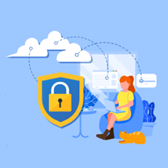 In the current era of remote work and digital cooperation, safeguarding the security of endpoints and devices has become crucial. With technology playing an increasingly significant role in communication, productivity, and innovation for organizations, protecting their data from malevolent parties is vital.
In the current era of remote work and digital cooperation, safeguarding the security of endpoints and devices has become crucial. With technology playing an increasingly significant role in communication, productivity, and innovation for organizations, protecting their data from malevolent parties is vital.
Unfortunately, many companies lack a comprehensive plan to safeguard their remote endpoints and devices from potential risks. Thankfully, there are several effective methods to ensure the protection of your data in this interconnected environment.
This article will outline the top seven ways to secure your remote endpoints and devices.
What Is Endpoint Security?
Endpoint security is the practice of securing the various endpoints or devices that connect to an organization’s network. These endpoints could include laptops, desktops, mobile devices, servers, and other network-connected devices. The main focus of endpoint security is to protect devices from cybersecurity threats such as:
- Malware
- Viruses
- Phishing attacks
- Other forms of malicious software
Proper endpoint security management ensures that the devices accessing the network are secure. It protects data stored on these devices from unauthorized access, theft, or corruption. This process typically involves a combination of tools, such as antivirus software, firewalls, intrusion detection/prevention systems, and other security measures.
Tips to Secure Remote Endpoints and Devices
As you can see, remote endpoint security is essential for businesses, regardless of their size and industry. Below is a list of tips to help you get started:
Tip 1: Use Antivirus and Anti-Malware Software
Antivirus and anti-malware software work by scanning files and software on a computer or other device for known malicious code or suspicious behavior. This software typically uses a signature-based approach, which involves comparing files and software to a database of known malware signatures to detect and block threats. It can also use behavior-based analysis, which looks for patterns of activity that indicate malware or other suspicious activity.
Tip 2: Implementing Multi-Factor Authentication
Multi-factor authentication (MFA) is an additional layer of security that requires users to authenticate their identity with more than one method. For example, a user might be asked to enter their password and then use a smartphone or other device to generate a one-time code. This process helps ensure that only authorized users have access to the system.
Tip 3: Remote Desktop Access Control
Without proper access control measures, remote desktops can be vulnerable to cyber attacks and malicious activities, such as data theft, ransomware attacks, and other types of cyber threats. By implementing remote desktop access control, organizations can limit access to remote desktops to only authorized users and devices. They can also set up policies and procedures for accessing and using remote desktops. This can help to prevent unauthorized access, mitigate the risk of cyber attacks, and protect sensitive data and information.
Tip 4: Network Security
Network security is a set of measures and technologies used to protect an organization’s network from malicious attacks. It includes firewall configuration, intrusion detection/prevention systems, antivirus software, and more. If possible, organizations should also consider implementing virtual private networks (VPNs) to further secure their networks from potential threats.
Tip 5: Employee Education and Training
Take the time to educate and train your employees on cybersecurity best practices. This includes teaching them how to identify suspicious emails, use strong passwords, avoid clicking on malicious links or attachments, and more. Additionally, have a formal policy in place that outlines the acceptable use of company resources and devices as well as procedures for managing remote endpoints and devices.
Tip 6: Regular Updates and Patch Management
You should ensure that all software and hardware are regularly updated with the latest security patches. Updates help keep systems secure by fixing any vulnerabilities or bugs that could be exploited by hackers. Additionally, you should use a patch management system to automate the process of updating and patching your systems, particularly for large networks with multiple devices.
Tip 7: Data Backup and Disaster Recovery Planning
Data loss or corruption can be devastating for organizations of any size. To protect your organization from this type of threat, you should implement a data backup and disaster recovery plan. This plan should include regular backups of all data stored on remote endpoints and devices as well as on-site backups in case of system failure or other disasters.
Tip 8: Proper Cable Management
Cable management refers to the process of organizing and securing the cables that connect devices to a network. Proper cable management can help improve endpoint security in several ways:
Minimizing Physical Access
By organizing cables, devices can be placed in secure locations and out of reach from unauthorized personnel. This can help prevent physical access to devices, which can be used to steal data or install malware.
Preventing Accidental Damage
Tangled or disorganized cables can pose a risk of accidental damage, which can cause device malfunctions or data loss. Proper cable management can help prevent accidental damage to cables and devices, which can help ensure they are operating securely.
Reducing Trip Hazards
Poor cable management can create tripping hazards in the workplace. Tripping hazards can lead to accidents, unplanned downtime, and data loss, which can greatly impact endpoint security.
Improving Airflow
Disorganized cables can block airflow, which can cause devices to overheat and malfunction. Proper cable management can help improve and prevent consequences of overheating, which can help ensure devices are operating securely.
Final Thoughts
Ensuring the security of remote endpoints and devices is essential for any organization. By following these best practices, you can help protect your organization from potential threats and ensure that remote endpoints and devices are operating securely.
